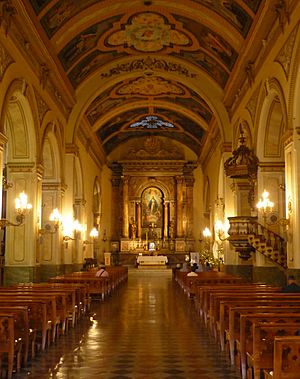Iglesia San Agustín, Chile facts for kids
Quick facts for kids Iglesia San AgustínIglesia de San Agustín |
|
|---|---|

Facade of Iglesia San Agustin
|
|
| Religion | |
| Affiliation | Roman Catholic |
| Ecclesiastical or organizational status | Church |
| Year consecrated | 1625, 2004 |
| Location | |
| Location | |
| Architecture | |
| Architect(s) | First Construction: Unknown Reconstruction: Julio Lepe |
| Architectural style | Spanish Baroque & Neoclassical |
| Completed | 1625 |
The Church of St Augustine, also known as Iglesia de San Agustín, is a historic Catholic church. It is located in downtown Santiago, Chile, at the corner of Agustinas and Estado streets. This church belongs to the Order of Saint Augustine, a group of priests and brothers.
Contents
History of the Church
When Was It Built?
The first version of the Church of St Augustine was built in 1608. However, it was later rebuilt. The current church was completed in 1625. This makes it the second oldest church in Chile. Only the Church of Saint Francis of Assisi is older. The Order of Saint Augustine started their work in Chile from this very church and its nearby monastery.
Architectural Style
The church shows a mix of styles. It was first built in the Spanish Colonial Baroque style. Later, parts were updated with Neoclassical features.
The Story of Cristo de Mayo
Inside the church, there is a special wooden statue of Jesus Christ called Cristo de Mayo. A famous local legend is connected to this statue. During a big earthquake in Santiago in 1647, the statue's crown of thorns slipped down to its neck. Someone tried to move the crown back up. But when they did, the statue's face seemed to bleed, and the ground started shaking again! Because of this, the crown has been left untouched. It still rests around the statue's neck today.
Saint Rita's Relic
The church also has a small altar dedicated to Saint Rita of Cascia. This altar holds a relic of hers. A relic is a small, important piece, in this case, a tiny bone fragment.
Church Design and Features
The Main Front of the Church
The front part of the church, called the facade, was redesigned by an architect named Fermín Vivaceta. This work began in 1850. He gave the church its current Neoclassical look. The facade has a decorative railing on top. This railing sits on six strong Doric columns.
See also
 In Spanish: Iglesia de San Agustín (Santiago de Chile) para niños
In Spanish: Iglesia de San Agustín (Santiago de Chile) para niños


